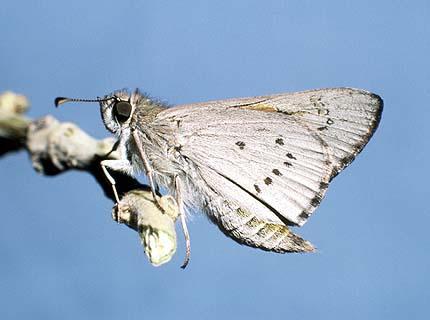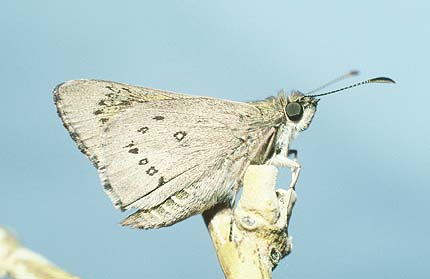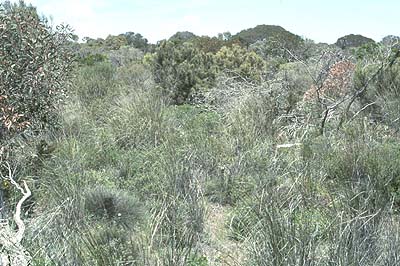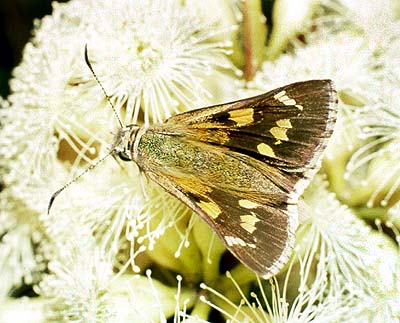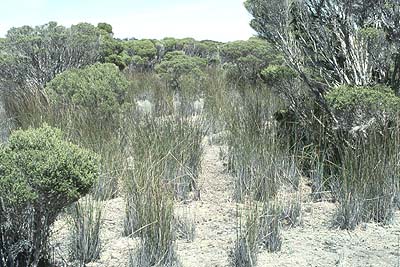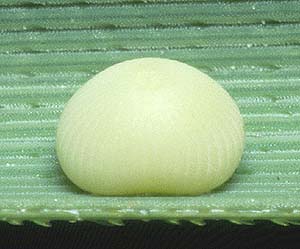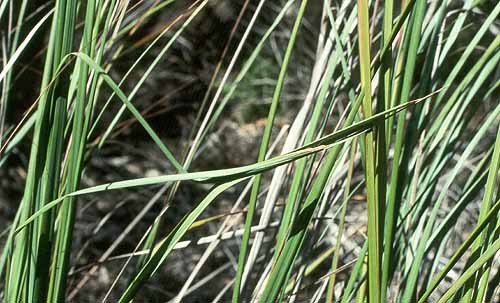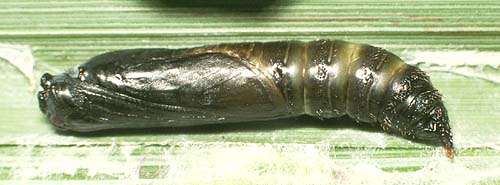-
Larval Food Host
-
The skipper uses the larger types of Gahnia saw-sedges as larva hostplants.
Dark form delos utilises
Gahnia clarkei (tall saw-sedge or cutting grass),
G. deusta (mallee saw-sedge),
G. filum (thatching grass or smooth-leaved saw-sedge),
G. radula (thatch saw-sedge),
G. sieberiana (red-fruit saw-sedge),
and G. trifida (cutting grass) (Cyperaceae).
Form flavescens utilises
Gahnia filum and G. deusta.
Intermediate forms will also utilise
Gahnia ancistrophylla (curly leaf saw-sedge),
as well as the other Gahnia.
The larvae eat the leaves of the hostplant. The skipper is not fussy about hostplant
growth position and will utilise plants growing in both shade and full sun.
Larvae of form flavescens have a decided preference for G. filum,
and will not readily transfer to other Gahnia species.
G. filum is tolerant of brackish wetland conditions and is usually found growing
in coastal estuarine and deltaic systems, whereas the other Gahnia require freshwater.
Females have an egg laying preference for the new succulent growth of young Gahnia plants,
or mature plants that are regenerating after a fire or after having been slashed.
-
Eggs
-
Large (2 mm along the long axis), hemi-ellipsoid with a flat base, nearly smooth with
about 36-50 very indistinct vertical ribs, and the micropylar area on top of the egg
is depressed. Eggs of form flavescens tend to have fewer ribs. Pale green when
new, but after 2 days if fertile the eggs become pale yellowish green and acquire a
ragged purplish dorso-lateral ring and a similarly coloured micropylar area or circular
dorsal patch. Laid singly on the outer leaves of the hostplant tussock, usually on a
leaf underside (if the leaf is drooping), near the leaf edge, and can be anywhere along
the long leaf, from the near the tips to near the base. The egg hatches after about 12
days in late spring (form delos), and after about 23 days in late autumn
(form flavescens). The egg shell is eaten by the larva after its emergence.
-
Larvae
-
The first instar is long cylindrical, and exits the egg already 5 mm long, mostly pale
yellow coloured but the mid-dorsal part is brownish, with five narrow longitudinal
dorsal and subdorsal brown lines that continue onto the anal plate, but which become
obscure near the neck. There is a large shining black head having a few long hairs,
the neck (prothoracic plate) is brownish black, the surrounding neck area is dark wine
red, and long recurved hairs occur posteriorly. After eating the empty eggshell the
larva will eat a small portion of the hostplant to test that it is the correct hostplant,
then it normally moves to near the tips of the leaves to form a small tubular shelter
opening at the top, by silking together two or three leaves. They will sometimes use
a single leaf by rolling the leaf near its tip to make the shelter. The young larva
gradually turns green as it eats the hostplant, and the dorsal areas between the brown
lines become whitish.
Subsequent instars gradually lose the long posterior hairs, and the head becomes brown
and eventually by about the third or fourth instar, acquires the pale brown head pattern
described for the final (usually fifth) instar larva. The brown dorsal lines become
dark brownish green and the white inter-areas remain. New silk lined tubular shelters
are periodically constructed to fit the growing larvae, using leaves of the hostplant,
the internal diameter of the shelters being a close fit to the diameter of the larvae.
The shelters are sealed at the base and open at the top (towards the tips of the leaves),
and in the case of this skipper, the leaves are usually silked together in a straight
manner. If the shelter is made in the outer parts of the hostplant then during its
development the larva will eat the leaves back from the tips towards the shelter entrance,
but once they have been demolished then the larva will eat from other leaves separate from
the leaves used to construct the shelter. Larvae feed at night for a very brief period
(usually very late at night), hiding from predators during the day inside their shelters.
The final instar is long cylindrical, about 25-38 mm long, with the last posterior segment
flattened into the anal plate, smooth, but with the posterior end having some hairs.
Green coloured, sometimes bluish or yellowish, with a darker dorsal line, and sometimes
there are other indistinct longitudinal lines when the larva is still in its early final
instar growth. The head is large, rugose, elongate, there is a distinct central longitudinal
furrow, the top is rounded, with a few long hairs ventrally and there are also some very
short frontal hairs that are bent and directed forwards. Pale brown coloured with a broad,
black, triangular shaped longitudinal median marking in the front that expands ventrally
and tapers to a point at the dorsal apex, the mouth parts are black, and there is also
sometimes an indistinct yellowish patch on either side of the mouth parts (between the front
and side stripes). The side of the head usually has a dark brown or brownish black vertical
stripe, which is broader basally, narrowing apically but which usually does not reach the
apex of the head to join with the frontal triangular mark. The side marking is also sometimes
absent, when the larva can then be mistaken for H. chrysotricha, but the former differs
by usually having the very broad frontal mark (always narrow in H. chrysotricha).
The body, and particularly the anal plate on the last segment, is covered in minute
secondary setae that are wine glass or vase shaped, and which are set on simple smooth
raised bases that are transparent along the body but black coloured on the anal plate,
the latter producing a finely speckled appearance. Near pupation the larvae turn
semi-translucent green and have a dark longitudinal dorsal line, and sometimes also a
subdorsal line.
The final larva shelter is usually constructed in the outer half of the plant, or rarely
at the base of an individual leaf, and is about 7 cm long. Shelters formed in the outer
parts of the hostplant are made by joining up to six hostplant leaves together, to form
a tight, strongly silk lined, usually straight tubular structure, sealed at the base and
opening at the top. Larvae normally continue to eat and develop slowly through winter,
but will sometimes pupate in winter. Dependant upon variable ecological factors, six larval
instars may sometimes be required rather than the normal five instars.
The presence of larvae for this species (and for all other Hesperilla larvae)
on the hostplant are readily discernible by the distinctive looping of the hostplant
leaves resulting from the construction of the larval shelter. The leaves used in the
construction of the shelter are tightly fixed by silk to form the shelter, and as the
leaves continue to grow (from the base) the unequal growth rate of each leaf causes
the fastest growing leaves to produce a loop beneath the shelter.
-
Pupae
-
Long cylindrical, about 16-28 mm long. The colour is variable from brown, to dark brown
or black, with variable amounts of green or yellow areas in the mid part, particularly
the abdominal area, but sometimes they can be nearly all a greenish yellow colour except
for a black head and dark brown posterior end. Pupae from the elevated areas near Mt Lofty
are usually entirely black. The green colour changes to the yellow colour as the pupae
mature. (All pupae are entirely green coloured when they are newly pupated).
Pupae are lightly covered in a white powdery bloom, the latter acting as a water repellent
and perhaps fungicide.
There are some short dark brown, posteriorly directed, stiff spinose bristles on the abdomen,
which become much more common towards the posterior end, and which arise from short conical
bases. There are also some erect bristles on the thorax. The posterior end tapers to a short,
wide, flattened, wedge or spade shaped, but dorsally ridged, dark brown or black coloured
cremaster. The head is anteriorly flattened, with the head cap (operculum) being black or
black and brown coloured, having a characteristic, anteriorly projected flat shape (in the
same plane), and there are some long hairs, particularly on the anterior parts of the eyes.
The central part of the operculum is black, heavily sclerotised (very rugose ) and is divided
into three, distinctly separated, and strongly elevated (anteriorly projected) parts. A larger
oval shaped ventral part, and two smaller equal-sized, sub-rectangular dorsal parts. The larger
oval shaped part can sometimes be indistinctly divided. There are further, smaller sclerotised
brown or black coloured areas lateral to the central part, on the anterior parts of the eyes.
Pupation occurs in the final larval shelter on the hostplant, and the larva pupates head
upwards towards the leaf tips. The pupa is secured within the silk lined shelter by very
strong hooked bristles emanating from the peripheral-ventral parts of the cremaster,
(same principal as velcro). The pupa duration is highly variable, depending on location,
hostplant, time of year, and size of pupa. Pupae that develop from larvae living on
Gahnia deusta are often small. The pupa duration is about 30-36 days in late
spring-early summer for larvae that develop on the large saw-sedges, but can reduce to
about 23 days for larvae that develop on G. deusta. In late summer the pupa duration
for all saw-sedges can be much shorter, from 7-15 days. In early autumn the pupa period
increases again, being 17-30 days. The empty pupa case remains inside the shelter after
the adult skipper emerges, and is brown, dark brown or brownish black coloured.
The shape of the operculum and cremaster, the colour of the pupa (alive or as an empty case),
and the morphological properties of the larva or discarded larval skin are diagnostic for the
species and can be used during field surveys to differentiate H. donnysa from other
Hesperilla species in South Australia outside of the flight times for the adult skippers.
-
Flight Period in South Australia
-
Form delos is single brooded in the elevated areas of the South Mt Lofty Ranges
and on Kangaroo Island, and has a late spring-early summer flight. Form flavescens
(and local intermediate form diluta) is double brooded, and has separate flights
in spring and autumn. Intermediary forms are mostly double brooded in South Australia,
but in some cool areas they may be single brooded. In the Southeast Region there is a
long continuous flight, but depending on the locality, is dominated either by a double
brood flight or a single brood flight. In the southern part of the Southeast Region
the flight occurs from late October to early March, and is dominated by a single brood
flight that peaks over summer.
Most main flights outside of the Southeast Region do not last longer than four weeks in
any single location. The double broods occur as two distinct broods that each usually
last one year, i.e. eggs laid in spring or autumn will respectively produce an adult
flight during the following spring or autumn, for brood periods of 12 months.
The skipper overwinters as larvae.

-
Distribution
-
The skipper occurs within the southern agricultural belt, wherever its saw-sedge hostplants
occur in a high enough density. In the drier parts of its range in mallee areas of
central Eyre Peninsula and the northern Upper Southeast Regions it occurs where its
host Gahnia deusta is growing.
The dark form of the skipper is found in the elevated areas of the South Mt Lofty Ranges,
on Kangaroo Island, and in many parts of the Southeast Region. Form flavescens
(flavia) historically had a major presence in the Gahnia filum wetlands
inland of the coastal beaches of Adelaide, extending north to Port Gawler. It is now
probably extinct in these areas due to urbanisation, by the gradual elimination of its
wetland habitat (which was historically viewed as waste-land), to produce the salt works,
Adelaide Airport, West Lakes, and the coastal golf courses. Until recently there was
a major G. filum wetland remnant containing the last known major population of
this form at St Kilda (originally known as
form flavia Waterhouse), but this was terminated by the use of sprays for mosquito
control and finally in 1997 the remnant wetland was illegally bulldozed by the Defence
Department. A similar pale form is a major component of the population that occurs on
Yorke Peninsula where the dominant saw-sedge is G. filum, although the skipper
morphology of this population is not as pronounced as for the now extinct St Kilda
population. The former population was historically distributed over the lower half of
the peninsula, but is now restricted to the extreme southern portion. There are also
odd historical records of form flavescens on southern Eyre Peninsula, and along
the Coorong and the odd esturine swamp further southwards in the Southeast Region, but
in both regions the form has very rarely been seen in recent years.
Saw-sedge remnants of Gahnia trifida also occur within the artesian mound springs
along the west side of Lake Eyre. These were recently examined for the presence of
H. donnysa, but there were no signs of the skipper. The early pastoralists savagely
degraded these areas, so it is not known if the skipper was ever present.
Other subspecies of H. donnysa are found in southwest WA, and in Tasmania and
nearby islands.
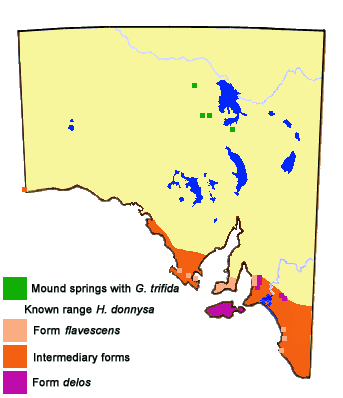
-
Habitat
-
The skipper utilises a wide variety of saw-sedges as larvae hostplants, and the latter occur
in diverse habitats, in coastal estuaries and deltas, and along the edges of some near
coastal salt-lakes (G. filum),
lowland freshwater wetlands (G. trifida),
upland wetlands (G. seiberiana),
cold sinkhole wetlands (G. clarkei),
moist forests (G. radula),
moist sand based woodlands (G. ancistrophylla),
and limestone based heaths and mallee woodlands (G. deusta).
-
Conservation Status in South Australia
-
Dark form delos and the intermediary forms of the skipper, although widely
distributed, are usually uncommon to rare in flight. However, there are sometimes
coincident emergences of the skipper where most of the population (within a single
locality) will emerge togetherover a few days, and the skipper can then be locally
common. Yet a week later, none will be seen due to dispersal. Form flavescens
in its extreme colour morphology, is now very rarely seen in South Australia.
Based on the extinction of the principal population near Adelaide, and due to the
dilution of the flavescens genetic component in other coastal populations by
the historical fragmentation and disruption of the coastal habitats, this form could
be considered endangered. The local pale forms of the skipper on Eyre and Yorke
Peninsula are presently stable and can be considered rare, but any further degradation
of their habitats and wetlands would make them vulnerable.
-
Threats
-
This skipper has suffered considerably from the agricultural and urban disturbances
of its saw-sedge wetland habitats. In historical times these wetlands were cleared,
drained and burnt off, but the tenacious regrowth habit of the saw-sedges often won
out. However, more aggressive farmers endured causing the wetlands to become severely
fragmented. Due to the tall tussock growth habit of the saw-sedges it is usually cattle
that are allowed to graze these wetlands, which they do very effectively when hungry,
by eating and trampling the sedges back to near ground level. Remnant saw-sedge bearing
creeklines and wetlands continue to be drained, dammed and degraded. The draining of
wetlands puts terminal summer stress on the saw-sedges causing them to in-roll their
leaves, which makes them unpalatable to the larvae of the skipper. Most remaining
saw-sedge bearing creeklines are now choked and smothered with weeds and introduced
trees, particularly African feather-grass, ash, blackberry, broom, couch, ivy and kikuyu.
Irresponsible disposal of urban and agricultural waste products and toxins inevitably
end up in wetlands, the effects of which are ultimately going to have a detrimental
effect on the wetland community, including this skipper.
-
Conservation Strategy
-
The retention of saw-sedge wetland habitat is essential for the continuing survival of
this skipper. However, because it has a wide range of saw-sedge hostplants the habitat
degradation has not had an unduly severe impact on its range. It is a very tough and
resilient skipper and is well adapted to the various saw-sedge habitats, and is capable
of persisting even in very degraded habitats. (It can subsist on dryland Gahnia deusta
if adjacent saw-sedge wetlands have been degraded). Even with minor rehabilitation of
the wetlands, this skipper would make a quick recovery.
For all species of Hesperilla skippers, there needs to be a major revegetation
of suitable creeklines and wetlands with the saw-sedge hostplants, and the latter should
be included in all revegetation projects. (The wetland species of saw-sedges require
'wet feet', but will not survive in permanent water.) Remaining saw-sedge wetlands used
for pastoral purposes need to be managed in an ecologically sustainable manner, and ideally,
key wetlands need to be fenced off from the destructive feeding habits of grazing domestic
stock. (Unfortunately, most wetlands on private land, usually dairy-land and small acreage
cattle holdings, are used as a backup food source for the cattle due to the adjacent pasture
land having been severely overgrazed.) Grazing rights on government lands need to be
monitored more carefully. Some light grazing of the saw-sedges can be beneficial to the
skipper larvae, as it produces succulent new growth and keeps the surrounding weeds down,
but heavier grazing is only beneficial if it is allowed on part of the wetland over a three
year cycle. The control of mosquitoes in remaining broad-acre saw-sedge wetlands through
the use of broad spectrum insecticides by aerial means needs to be judicially controlled,
but preferably should cease, as it can be a major cause of fauna destruction. Such use of
aerial insecticides was a major contributing factor to the demise of the last areas of
habitat for form flavescens north of Adelaide. The draining of remaining pristine
wetlands needs to cease, as this practice causes summer stress to the Gahnia that
is ultimately fatal to Hesperilla larvae. The dumping of urban vegetation waste into
creeklines and wetlands needs to cease. There needs to be a major public education process
about the continuing degradation effects on wetlands.
